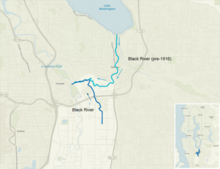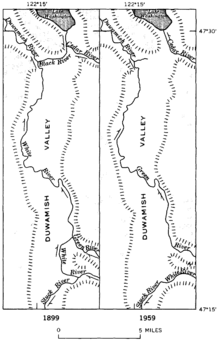Black River (Duwamish River)
The Black River is a tributary of the Duwamish River in King County , Washington state . It drained Lake Washington until 1916 , when the opening of the Lake Washington Ship Canal lowered the lake's water level, which partially led to the Black River drying up. It still exists as a back-dammed river about two miles (3.2 km) long.
Before the 20th century, Lake Washington had an outflow in the south over the Black River, which was reinforced by the Cedar River before it flowed into the White River (today in the lower Green River - the White River has shifted its course to the south) . The confluence of the Black and White Rivers formed the Duwamish River, which flows into Elliott Bay on Puget Sound . Therefore, the waters that flowed into Lake Washington, such as the Sammamish River , once drained over the Black and Duwamish Rivers . Today the water of Lake Washington flows into the Puget Sound via the Lake Washington Ship Canal .
In November 1911, the Cedar River flooded Renton. In 1912 the Cedar River was diverted from the Black River into Lake Washington to prevent future flooding. The water continued to flow through the Black River after it passed Lake Washington. With the opening of the Lake Washington Ship Canal in Seattle in 1916 , the lake's water table dropped nearly nine feet and the Black River dried up. Today, part of the bed forms the alluvial forest and wetland of the Black River Riparian Forest and Wetland .
The Duwamish lived along the Black River for several centuries. The Duwamish settlements remained on the river until it dried up in 1916. Several indigenous villages were located at the confluence of the Black and Duwamish Rivers. The area was called "Inner Place" ( Lushootseed : Dx w dəw , from which the word "Duwamish" was derived), which refers to the location inland of the Puget Sound. Long used as a retreat, the area became home to many Indians who were displaced by the expansion of the city of Seattle until the Black River dried up.

See also
Individual evidence
- ↑ Black River in the United States Geological Survey's Geographic Names Information System
- ^ "The Green-Duwamish: A River System Re-Plumbed," The Green-Duwamish River: Connecting people with a diverse environment . Duwamish River Cleanup Coalition / TAG. Without a date, appears to be from 2008 or 2009.
- ↑ Cedar River floods Renton in November 1911 . Archived from the original on June 11, 2011. Retrieved September 1, 2009.
- ↑ Black River disappears in July 1916 . Retrieved February 9, 2018.
- ^ Black River Riparian Forest and Wetland . Retrieved February 9, 2018.
- ^ Herons Forever , History of the Black River
- ^ Coll Thrush: Native Seattle: Histories from the Crossing-Over Place . University of Washington Press, 2007, ISBN 0-295-98700-6 , p. 244.
- ^ Lynda Mapes: Water's natural rhythms nourished our area's native culture. Then came the Ballard Locks. . Retrieved July 5, 2017.
Web links
Coordinates: 47 ° 28 ′ 27 ″ N , 122 ° 15 ′ 3 ″ W.

